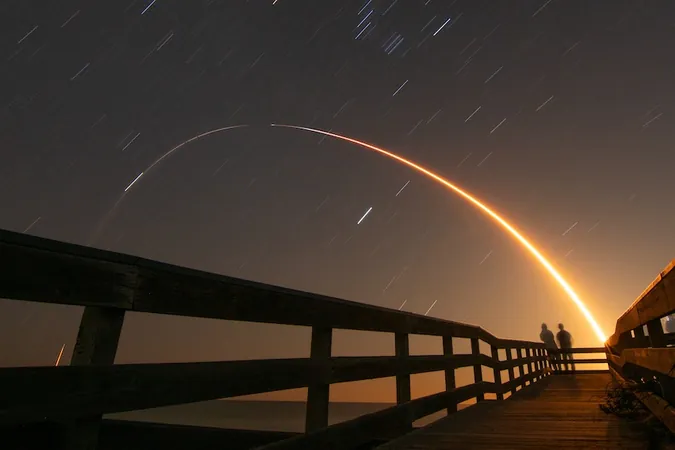
SpaceX Kicks Off 2025 with Successful Falcon 9 Launch for UAE’s Thuraya 4-NGS Satellite
2025-01-04
Author: Chun
SpaceX's First Launch of 2025
In a remarkable start to the new year, SpaceX achieved its first orbital launch of 2025, successfully deploying the Thuraya 4-NGS telecommunications satellite for the United Arab Emirates. The Falcon 9 rocket took off from Cape Canaveral Space Force Station at precisely 8:27 p.m. EST on January 3, 2025, marking a significant milestone in the increasing globalization of telecommunications services.
As cloud cover rolled in, the 45th Weather Squadron provided a favorable weather forecast, estimating a 95% chance of good conditions at the beginning of the launch window. However, concerns about liftoff winds prompted continual monitoring, highlighting the ever-present need for meteorological precision in space endeavors.
This recent mission saw the quiet but impressive first-stage booster of Falcon 9, identified as B1073, achieve its 20th launch. Previous missions for this booster included resupply missions to the International Space Station and multiple batches of Starlink satellites, highlighting SpaceX's growing impact on global connectivity. Landing nearly 8.5 minutes after liftoff on the droneship “A Shortfall of Gravitas,” this successful recovery contributed to SpaceX's record of 391 booster landings to date.
Boosting Connectivity with Thuraya 4-NGS
The Thuraya 4-NGS satellite represents a significant advancement in global telecommunications. It is operated by Space42, a newly formed conglomerate resulting from the merger of UAE’s prominent satellite provider Yahsat and AI-driven geospatial solutions company Bayanat. This merger aims to enhance satellite capabilities while integrating advanced AI technology for improved service delivery.
Currently, Space42 oversees two operational geostationary satellites: Thuraya 1 and Thuraya 2, which have been serving various customers across Africa, Central Asia, Europe, and the Middle East since their launches in the early 2000s. However, Yahsat recently reported challenges with Thuraya 3, which experienced an unexpected anomaly leading to ongoing service disruptions. This has resulted in a notable decline in revenue, underlining the importance of Thuraya 4-NGS in restoring reliable services and expanding connectivity.
Built by aerospace giant Airbus, the new satellite features cutting-edge technology, including a 12-meter antenna and advanced routing and dynamic power allocation capabilities. Once fully operational, Thuraya 4-NGS is expected to introduce over 15 new products to the market, marking a new era for Yahsat's service offerings.
"Thuraya 4 is at the core of our next-generation mobility solutions plans and demonstrates our commitment to harnessing advanced SpaceTech," stated Ali Al Hashemi, CEO of Yahsat Space Services. "This launch is not just a step forward for our company; it's also a leap for the regions we aim to serve."
SpaceX was selected for this mission back in September 2021, with the satellite construction beginning shortly after and the delivery to Florida occurring in late November. Originally scheduled for a 2023 launch, its deployment has been eagerly anticipated as a vital stepping stone toward revitalizing satellite communications for a diverse customer base.
As we look ahead, this successful mission serves as a powerful reminder of the accelerating pace of innovation in space technology and the ongoing quest for enhanced global connectivity. What further advancements await us in the realm of space exploration and telecommunications? Stay tuned, as 2025 promises to be an exhilarating year for space enthusiasts!




 Brasil (PT)
Brasil (PT)
 Canada (EN)
Canada (EN)
 Chile (ES)
Chile (ES)
 España (ES)
España (ES)
 France (FR)
France (FR)
 Hong Kong (EN)
Hong Kong (EN)
 Italia (IT)
Italia (IT)
 日本 (JA)
日本 (JA)
 Magyarország (HU)
Magyarország (HU)
 Norge (NO)
Norge (NO)
 Polska (PL)
Polska (PL)
 Schweiz (DE)
Schweiz (DE)
 Singapore (EN)
Singapore (EN)
 Sverige (SV)
Sverige (SV)
 Suomi (FI)
Suomi (FI)
 Türkiye (TR)
Türkiye (TR)